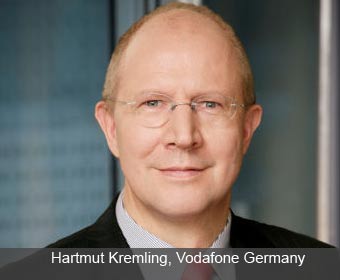Vodafone Germany has become the latest European LTE cheerleader, having accomplished the impressive feat of launching LTE service on December 1, 2010, a mere seven months after acquiring the relevant spectrum under auction. Ahead of his appearance as one of the keynote speakers at the upcoming LTE World Summit 2011, Hartmut Kremling, Vodafone Germany’s chief technology officer talked to Telecoms.com about the deployment.
May 10, 2011

Vodafone Germany has become the latest European LTE cheerleader, having accomplished the impressive feat of launching LTE service on December 1, 2010, a mere seven months after acquiring the relevant spectrum under auction. Ahead of his appearance as one of the keynote speakers at the upcoming LTE World Summit 2011, Hartmut Kremling, Vodafone Germany’s chief technology officer talked to Telecoms.com about the deployment.
“We are now well on track,” says Kremling, “and I am really, positively surprised regarding the stability and performance of this generation of this technology.” However, he said that the speed of the rollout presented greater challenges than 3G, where there was a three year gap between the acquisition of spectrum and the rollout of the UMTS network. “The key challenge with LTE was more or less, the speed [of deployment]. One of the key challenges was to parallelise eight development and test streams together – it was not possible to do it sequentially. It’s a new technology to put in place, from the transmission tower to the handsets.”
But LTE handsets are yet to hit the European market. “At the moment we’re working with modems and dongles. The good question at the summit will be: ‘when will the handsets come?’ We have seen LTE handsets in the US and I’m in direct contact with our partner Verizon Wireless,” he says. The US carrier already has a commercial LTE handset on sale – the HTC Thunderbolt. But Kremling explained that Verizon’s handsets can’t be simply brought over to Europe due to spectrum frequency differences. “Its 700MHz for the US market and 800MHz across Europe,” he says, yet he is still very confident that it is but a short hop for 4G handsets to come to market. “The developments are on the way – it’s just the next step in the chipset, it’s simple. It’s on the roadmap. The key question is more or less when will we see multi-band, multi-system handsets, for 2G, 3G, EDGE, wifi and 4G”.
While many industry pundits are predicting that LTE will enable radically new types of applications, for Vodafone’s LTE customers right now the benefits are quite straightforward. “It’s simple,” Kremling said. “It’s just speed. 3G is really fast in Germany, but [LTE] is another [level] of user experience. The delay time is much, much less, and the round trip is in the range of 30 milliseconds, drastically faster than 3G.” However, Kremling wouldn’t be drawn on the details concerning real world LTE speeds. “Let’s leave this as a secret for the summit,” he says. “The message today though is that I have been positively surprised at the throughput.”
As part of its spectrum auction win in May last year, Vodafone acquired 10MHz of 800MHz bandwidth. Under the licensing requirements, all winners of this frequency were required to provide service to rural communities first and Kremling confirmed that this rollout is well under way. “We have started out commercial service in the rural areas. There are so called ‘white spots’ – without broadband – fixed or mobile – and LTE 800 is a perfect technology to cover these wide areas quickly and efficiently. And we really have great feedback from the people there. There was no fast internet there at all and now it’s very fast,” he says.
But the high cost of deploying LTE networks prompted some talk of network sharing in Germany, particularly in the rural areas, however, Kremling scotched talk of network sharing.
“The network is entirely our own. There were some discussions, but in the end the question is what the business case is. There was a famous external benchmark – a connect test. We won this in 3G and 2G over the last six/seven years and it gives us an opportunity for differentiation in networks. Why should we give this up for the next generation of technology?”
Adopting the stance that competition is driving performance, Kremling also implies that LTE could pose a threat to fixed line operators too. “The key question from the customer’s point of view is: do I want the highest speed in just the living room, or high speed broadband all over? LTE is the perfect solution for high speed broadband all over. In Germany we can make that change with 800MHz and we have the chance to add capacity to the spectrum we have, paired or unpaired.”
But Kremling admitted that deployment might not be as simple in other places in the world, although Vodafone Germany will be keen to impart the learnings from its experience to others in the group. “A lot depends on available spectrum. There is no one fits all strategy. Therefore it’s important to look country by country. It depends on competitiveness and coverage applications. But the foundation of the technology – that it is all-IP, the core issues, the planning tools and basics – we are developing knowhow to give to our group colleagues. There is a lot of key learning for the whole Vodafone group we can collect in Vodafone Germany. Of course we are very connected to all of our colleagues, that it’s a common approach for us – teamwork.”
Hartmut Kremling will be giving a keynote presentation on Vodafone’s initial LTE experiences on day two of the LTE World Summit.
Read more about:
DiscussionAbout the Author(s)
You May Also Like








.png?width=300&auto=webp&quality=80&disable=upscale)


_1.jpg?width=300&auto=webp&quality=80&disable=upscale)


.png?width=800&auto=webp&quality=80&disable=upscale)